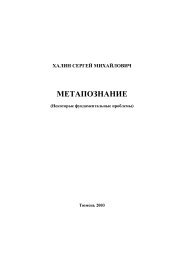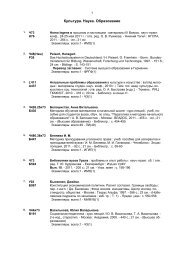The Economic History of Byzantium - Dumbarton Oaks
The Economic History of Byzantium - Dumbarton Oaks
The Economic History of Byzantium - Dumbarton Oaks
Create successful ePaper yourself
Turn your PDF publications into a flip-book with our unique Google optimized e-Paper software.
<strong>The</strong> Role <strong>of</strong> the Byzantine State in the Economy 977<br />
<strong>The</strong> fifth text is the summary treatise on public finance contained in Greek codex<br />
173 (12th century) in the library <strong>of</strong> San Marco. 7 This is the most systematic text we possess.<br />
It begins with texts concerning weights and measures and continues with definitions<br />
<strong>of</strong> land and the “regime” under which it may be held, <strong>of</strong> tax relief and its abolition,<br />
<strong>of</strong> the techniques <strong>of</strong> composing fiscal documents, and on the calculation <strong>of</strong> the<br />
land tax—more specifically, <strong>of</strong> the methods <strong>of</strong> epibole and hikanosis, discussed below. <strong>The</strong><br />
text seems to have been compiled by a civil servant who had access to the fiscal archives.<br />
<strong>The</strong> treatise in the San Marco codex has been dated to the tenth century (G. Ostrogorsky)<br />
and to between 912 and 1139 (F. Dölger). Since this text, too, appears to be aware<br />
<strong>of</strong> the changes in the manner <strong>of</strong> collection <strong>of</strong> the synetheia and the elatikon, Ibelieve<br />
that it ought to be dated after 1095 and before the date at which the San Marco manuscript<br />
was copied, that is, the first half <strong>of</strong> the twelfth century.<br />
<strong>The</strong> sixth text is the treatise on public finance in codex 121 <strong>of</strong> the monastery <strong>of</strong> St.<br />
Nikanor at Zaborda (a miscellaneous codex <strong>of</strong> the 13th century). 8 <strong>The</strong> text has survived<br />
in truncated form and seems to have been written as an aid to the teaching <strong>of</strong> taxation<br />
practice, which explains why it is in question-and-answer form. It consists primarily <strong>of</strong><br />
definitions concerning the exploitation <strong>of</strong> land and its taxation. It seems to me that<br />
the leavesonwhich this text is written clearly date from after the eleventh century (the<br />
period proposed by its editor). I would place them in the twelfth century, or perhaps<br />
even inthe early thirteenth century. As for the text itself, we can see that it is familiar<br />
with the changes in the collection <strong>of</strong> secondary taxes that came about after 1095; that<br />
it seems to be describing a situation subsequent to the reforms <strong>of</strong> Alexios Komnenos<br />
(1109/10); and that it refers to the pronoiatika, indicating familiarity with the institution<br />
<strong>of</strong> pronoia, which was introduced in the twelfth century. Given also the date <strong>of</strong> the<br />
manuscript, we can conclude that the text must date from the twelfth century.<br />
Finally, the seventh text, known as Apokope psomion, has survived in codex Vaticanus<br />
palatinus 367 (14th century, together with texts about Cyprus). It was published by F.<br />
Uspenskii and S. Lambros, 9 and there are commentaries by F. Dölger 10 and N. Svoronos.<br />
11 According to Svoronos, this brief text—which is <strong>of</strong> no metrological interest but<br />
states only the extent to which land should be taxed according to its quality (tà dhmósia<br />
th'" gh'" uJpárcwsin ou”tw")—should be dated to 1232.<br />
How reliable are these texts? In my opinion, they are highly, if not completely, trustworthy.<br />
In the few surviving texts that deal with land that did not receive special treat-<br />
7 Forarecent edition, see F. Dölger, Beiträge zur Geschichte der byzantinischen Finanzverwaltung besonders<br />
des 10. und 11. Jahrhunderts (Munich, 1927), 113–23.<br />
8 Published in J. Karagiannopoulos, “Fragmente aus dem Vademecum eines byzantinischen Finanzbeamten,”<br />
in Polychronion: Festschrift Franz Dölger zum 75. Geburtstag, ed. P. Wirth (Heidelberg, 1966),<br />
318–34.<br />
9 F. I. Uspenskii, “Vizantiiskie Zemlemery,” in Trudy VI arkheologicheskogo s”ezda v Odesse, 1884<br />
(Odessa, 1888), 306; Sp. Lambros, in Néo" JEll. 15 (1921): 345–47.<br />
10 Dölger, Finanzverwaltung, 56.<br />
11 Svoronos, Cadastre, 125. Cf. A. E. Laiou, “<strong>The</strong> Agrarian Economy, Thirteenth–Fifteenth Centuries,”<br />
EHB 329–32.








